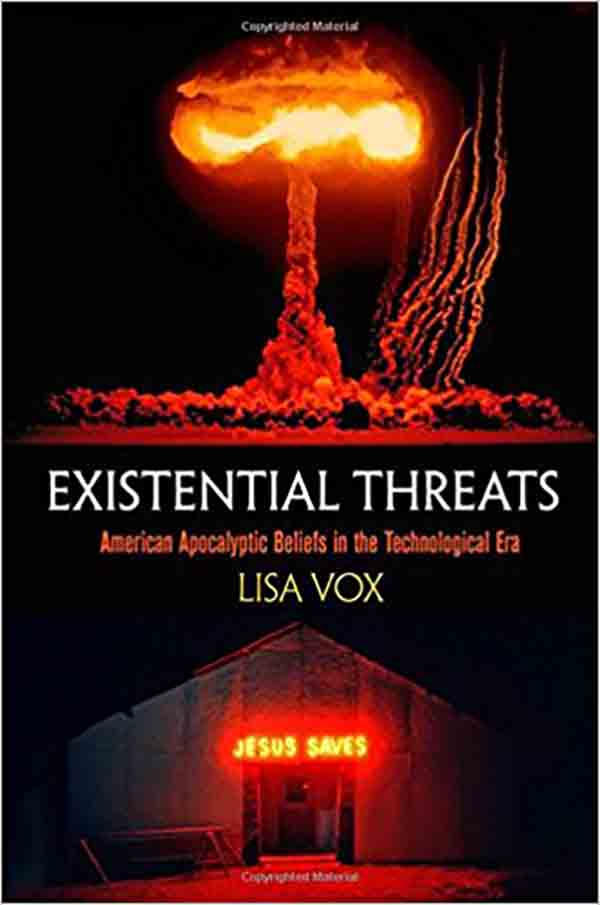‘It’s the end of the world as we know it,” sang Michael Stipe in R.E.M.’s 1987 hit song, “and I feel fine.” The end of the world, doomsday, the apocalypse, the end of days: Whatever one chooses to call it, it has always been a curiously seductive idea.

BOOK REVIEW — “Existential Threats: American Apocalyptic Beliefs in the Technological Era,” by Lisa Vox. University of Pennsylvania Press, 288 pages.
All of us, of course, know we’re doomed to die someday, a realization that usually comes very young with the death of a beloved dog, cat, or goldfish. But the end of the world is something else. It’s not just your world that dies — it’s everyone else’s too, and pretty much all at the same time. The idea of humanity united in oblivion, dying as a communal experience, seems to have a special purity, at one blow settling all accounts, solving all problems, wiping the slate clean. Yet at the same time, it’s the unspeakable, unimaginable horror, the ultimate failure, something to be avoided at all costs.
Maybe that odd admixture of horror and seductiveness is why doomsday narratives have been part of human culture since ancient times. For most of history, they were just stories, however fervently believed — based in the supernatural rather than in scientific reality. Then in the 19th century, the work of scientists such as Charles Lyell and Charles Darwin showed that the Earth was far older than previously thought and that living creatures didn’t just spring into being by God’s creation but had evolved (and eventually also succumbed to extinction) over deep time. Whereas before, the world could end only through divine fiat, now doomsday was imaginable without any God at all.
“Westerners did not seriously consider that the world could end without a supernatural cause until scientists offered a convincing explanation for a naturalistic origin of the world,” writes Lisa Vox in her new book “Existential Threats: American Apocalyptic Beliefs in the Technological Era.” Vox, an expert in American history and history of religion at the University of Massachusetts, Boston, approaches doomsday from both a professional and personal perspective, noting in the book’s preface that growing up in the “Southern Baptist stronghold” of Memphis, Tennessee, “bathed my childhood in apocalyptic anxiety.”
Such familiarity with American dispensationalist religion informs the book: Vox uses it as a springboard for an examination of how such religious notions as the Second Coming, the Rapture, and the rise of the Antichrist have influenced and intertwined with the secular apocalypticism of environmental disaster, nuclear war, worldwide plagues, and killer asteroids. Beginning in the 19th century, with Mary Shelley’s 1826 novel “The Last Man” and several similar contemporary works, she proceeds steadily through Jules Verne, H.G. Wells, and the beginnings of science fiction as a defined literary genre in the 1920s all the way through the world wars, the atomic age, the environmental movement, to 21st-century terrorism. Vox argues that although the apocalyptic anxieties fostered by such events have been secularized, they inevitably draw heavily from religious roots. But the influence hasn’t been solely in one direction: Religious writers, clergy, and evangelicals have readily borrowed scientific ideas to support their own ideologies.
The 19th-century English clergyman John Nelson Darby is generally considered the originator of dispensational premillennialist theology and the chief evangelist who spread it from England and Ireland to the United States, but others quickly embraced its core ideas and added their own, spawning a bewildering array of new doctrines and even formal denominations. That makes tracing its pathway through American culture a challenging task, but Vox mostly succeeds, though at times the arcane complexity of premillennial doctrine makes the journey rather confusing.
She is less successful in attempting to argue that the frequent similarities between religious apocalypticism and scientifically-based secular doomsday scenarios, or the fact that evangelicals such as Hal Lindsey or Tim LaHaye incorporated science into their prophetic writings and biblical interpretations when it was convenient, show that scientific views were somehow informed by dispensationalist doctrine. The frequent parallels between religious apocalypticism and scientific ideas definitely exist, as Vox demonstrates, but such similarities don’t grant each an equal validity. The many climate researchers and evolutionary biologists who have faced the condemnation of fundamentalist leaders and their political allies might also take issue with Vox’s assertion that “when there appeared to be conflict between the two apocalyptics, scientific apocalypticists were the ones who initiated it by painting premillennialists in an unflattering light.”
Vox has certainly done her literary homework in “Existential Threats,” discussing a dizzying variety of works. Rather than limit herself to the obvious choices of doomsday science fiction visions, she looks at a wide array of fiction and nonfiction works, films, even poetry. Such a comprehensive treatment of so many sources risks becoming more of a cursory survey of the genre than a deeper analysis, and the book might have benefited from a slightly less comprehensive approach in favor of a detailed focus on fewer works. But “Existential Threats” still provides an invaluable overview of America’s literary culture of apocalypse in the light of our persistently pervasive religious traditions.
Mark Wolverton is a science writer, author, and playwright whose articles have appeared in Undark, Wired, Scientific American, Popular Science, Air & Space Smithsonian, and American Heritage, among other publications. His most recent book is “A Life in Twilight: The Final Years of J. Robert Oppenheimer.” In 2016-17, he was a Knight Science Journalism fellow at MIT.











Comments are automatically closed one year after article publication. Archived comments are below.
This review definitely left me wanting to know more about “Existential Threats”, which I guess means a reviewing job well done (!). From what is said here, however, I rather doubt that Lisa Vox is concerned so much with the “validity” of religious versus scientific apocalypticism, but rather with the historical and cultural resonances between the two. for the existence of the latter, it seems to me, the evidence is rather clear. After all, wasn’t it J. Robert Oppenheimer (about whom our reviewer has written an excellent book) who said, “the physicists have known sin”?
All I have to say that’s relative to the discussion of death is that the end of an individuals life appears to be a part of our evolutionary process. Especially when we have children to carry on the instinctive behavioral strategies that we’ve caused them to inherit. In which case, our bodies die, but our intelligent life lives on. And I might add that our bodies will feel nothing after our intelligence leaves them. In other words, we’ll never know we’re dead, and will certainly never feel it.
(I’ve written a book that deals with our strategic purposes, but I won’t try to sell it here!)
@Roy
The best thing about Humanity was our triumph of passing knowledge on to the next generation. Things changed fast in evolutionary terms once writing ideas down became common place. Strategic insemination of ideas is a complicated topic especially considering how ego and greed driven people are. Your book sounds interesting.
The thing I disagree with is that we won’t feel death or know what is happening after we’re dead. We most certainly do feel sickness that leads to death. As someone who has died, someone who has tripped to something else, I think we are still to lost in the universe to know if we actually die or not. Some people even have experiences after they are dead.
Sounds like mumbo jumbo when I type it out, I’m 50/50 on whether there is mind/spirit after death. I don’t believe in god, I do believe in life though.
It’s a strange world we live in and anything is possible.
I have a problem with one of the rhetorical sentences, no, we are not all necessarily going to die. This is a traditional aging trance to which society has succumbed. There is a very large number of scientists researching this area and at some point death will become an option. With telomerase, embryonic stem cells, Sirtuins, metformin, DNA research, etc. it’s only time.